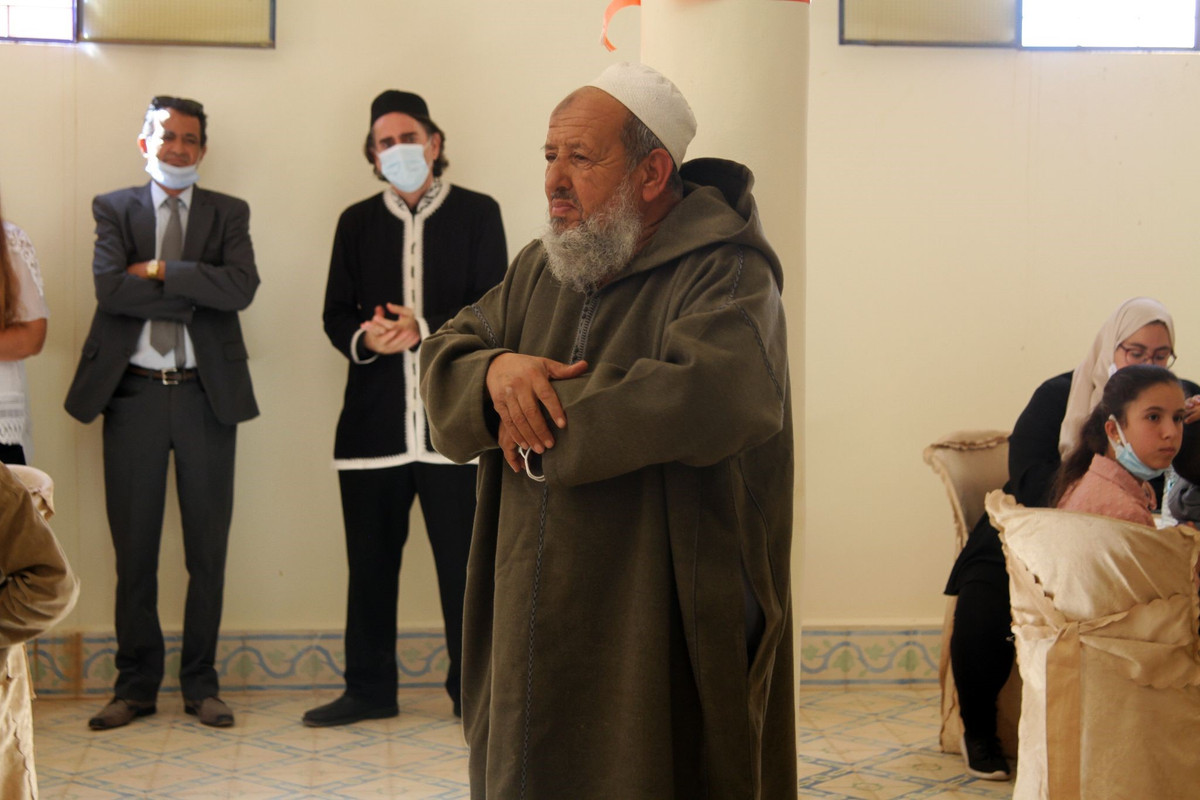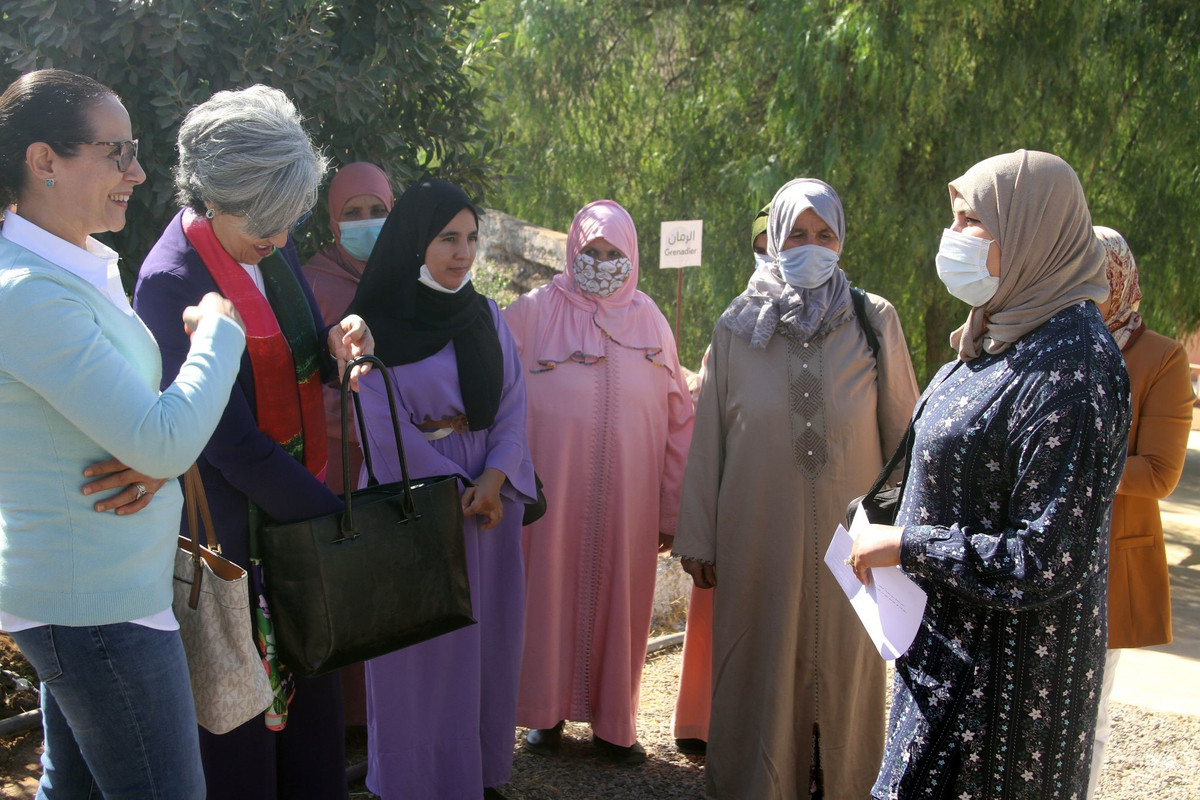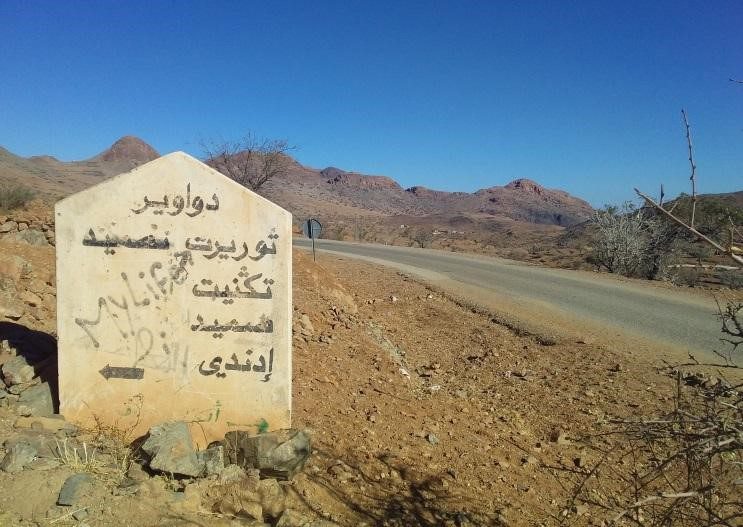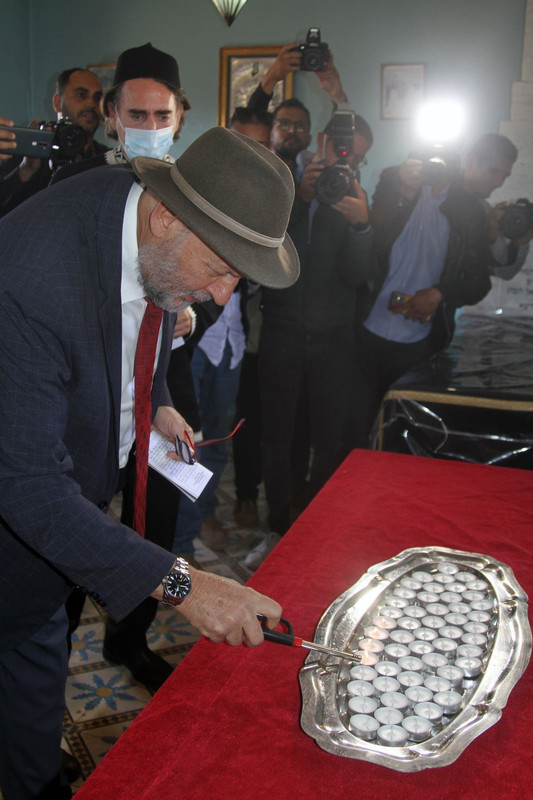What brings people together in celebration of heritage, cultural identity, and solidarity for our individual histories? This week in Morocco’s Al-Haouz province, 30 kilometers from Marrakech, what it took was an openness to acknowledge and celebrate one another, a warm autumn day, the participation of a vibrant and diverse group of communities coming together to share their stories, and the symbolic gesture of planting a single fig tree in a 700-year-old Jewish cemetery.
On Tuesday, November 2, 2021, several High Atlas Foundation (HAF) team members came together for the first community storytelling gathering held within the framework of the USAID Religious and Ethnic Minorities Activity (REMA), which is implemented by HAF in Morocco, during an event at the interfaith fruit tree nursery in the village of Akrich. The gathering brought together local Muslim farming families, members of the Marrakech Jewish community, the women of the Achbaru Carpet Collective, and local officials, together with the U.S. Consul General Lawrence Randolph and Director of Dar America Michelle Outlaw in celebration of the Akrich community and its heritage.
The day started with a shared visit to the Shrine of the Holy Rabbi Raphael HaCohen and the ceremonial lighting of candles and intention-setting. Jacky Kadoch, the President of the Jewish Community in the Marrakech-Safi region, shared his hopes with all who gathered.
“I wish for peace. Not just throughout Morocco but in the world. We need more peace, and this is always my wish. This very sacred site is a powerful place for many reasons, including the sacred burial site of a saint,” expressed Mr. Kadoch. “Akrich holds an atmosphere that all can feel when they visit. It’s a feeling of peace and of welcoming, it is a feeling of safety.”
President of the Jewish Community in the Marrakech-Safi region Jacky Kadoch (left) and Project Director of Rebuilding Our Homes (ROH) Maroi Ech-Charkaouy (right) of Association Mimouna, in the Shrine of Hebrew Saint Rabbi Raphael HaCohen for the ceremonial lighting of candles. November 2021. Photo: HAF
As he reflected on his wishes for the country of Morocco and the importance of Akrich to so many communities standing together before him, a powerful atmosphere emerged. We stood together, a truthful testament to Morocco and beyond that the peaceful space we were sharing was our revelation: Muslim, Jewish and Christian people from throughout Morocco and from various countries and continents around the world stood together in a Jewish cemetery in Morocco lighting candles and sharing our hopes for humanity.
Encouraging the energy of the moment, HAF President and REMA Chief of Party Dr. Yossef Ben-Meir then brought the participants together to share personal stories and testimonials of lived Moroccan multiculturalism. “We are here to share our stories of remembrance and experience as individuals and as Moroccans,” Dr. Ben-Meir declared. “We are standing together to share our stories of existence here in Akrich because we have all felt something while standing in this space. We all have a reason to express how we felt when we first arrived in Akrich, whether that day was just today or three months ago or ten years ago. We can all identify what has brought any of us together now, why we have come back to Akrich, or traveled here for the first time.”

A local of Akrich and retired university professor Moulay Abderrahman El Mghari shares his story of living in the Al Haouz region and how he personally benefited from trees planted with the High Atlas Foundation, November 2021. Photo: HAF
One by one, people stood up to share their personal experiences. One man, a farmer named Faissal from the rural Chwirji commune in Amizmiz, took the floor. “I came here for the first time three months ago and was greeted by a community that took care of itself. It was unclear to me from the beginning who was responsible for what, or who was Jewish and who was Muslim. All that I could see was that everyone was working together, living side by side, caring for a nursery and tending to a cemetery, welcoming one another and sharing a feeling of inclusion.”
Dr. Fatima-Zohra Iflahen, the Vice President of Cadi Ayyad University in Marrakech, spoke of Akrich and the powerful act of planting a tree: “Akrich represents a special place because of the Muslim and Jewish heritage that is historically and presently represented here. Coming together like this today is symbolic for many reasons, but what I think is most important in Akrich is that, throughout history here, Muslim people have honored Jewish history. And what a simple and so powerful gesture to do. If it’s one of the last things that you’ll ever do when you leave your legacy, plant a tree. What a thing of beauty it is to plant these trees together.”

Several members of the women’s Achbarou Cooperative and HAF-REMA team member Fatima-Zahra Laaribi share a moment together in the first HAF House of Life interfaith nursery in Akrich, November 2021. Photo: HAF
While this is just the first activity of many that will take place over the next three years throughout Morocco, it was emblematic of the REMA program’s unique participatory approach to the educational preservation of Morocco’s multicultural history. This first activity marked the beginning of an inspiring collaborative effort devoted to supporting community cultural heritage dialogue, storytelling, and memory preservation.This opportunity to collect these individual and communal stories of Morocco’s multicultural past and present is timely and necessary. Time is of the essence, as the stories of older generations are at risk of being lost. It is therefore of vital importance to find and share them in order to immortalize the experiences of the people of the various identities that have existed and exist today throughout Morocco. In doing so, our actions are akin to planting trees: something precious is not only preserved, but its roots also grow strong, securing a stable and proud foundation, its life extending far into the future.
—
The community-managed Akrich nursery is built adjacent to the seven-hundred-year-old tomb of Rabbi Raphael HaCohen. The first HAF House of Life interfaith nursery, it champions the notion that Morocco’s multicultural past and present, and the preservation of it, should advance the sustainable development of the country by providing a tangible and vital pathway for the social and economic benefit of generations of Moroccans. Since 2012, nearly 240,000 seeds have been planted here, with 10,000 pomegranate, 6,000 fig, and 24,000 carob saplings currently growing and to be distributed to farming families throughout Morocco beginning in December, 2021.
HAF extends thanks to all who dedicated time to participating in the event, including Mohamed Moukhlis, the Provincial Director of the Department of Water and Forest of Al Haouz, and Mendili Moulay Abdellah, the Regional Director of the Department of Agriculture of Marrakech-Safi.
The USAID REMA program in Morocco, which is implemented by the High Atlas Foundation and its partners, aims to collaboratively develop and pioneer a unique participatory approach to the educational preservation of Morocco’s multicultural history. Its goal is to explore and strengthen inter-religious and inter-ethnic solidarity and community efforts that preserve cultural heritage in Morocco by: 1) Supporting community cultural dialogue and storytelling, heritage knowledge-building, and memory preservation, and 2) Engaging in applied learning for internalization and transmission of Moroccan multiculturalism and capacity-building in employability.
Read and view more from REMA.









